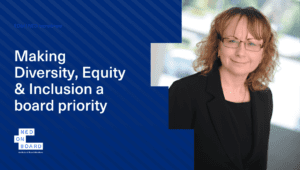The 2019 report of the Hampton-Alexander Review was published in November. This is the fourth annual publication of the UK government-backed initiative to improve gender diversity and balance in FTSE leadership. The report highlights two important facts:
- Women on boards – FTSE 350 companies have hit the target of achieving 30% of board roles held by women. This is a milestone and a material improvement from the under 10% of female representation 10 years ago. There are only two companies within the FTSE 350 that still have an all-male board (2018: 5) and 39 that only have a single woman on their board (so called the “one and done”, 2018: 74). That said, only 25 boards have female chairs.
- Women in senior executive leadership positions – Progress to improve gender diversity in executive leadership roles has been limited and there is still a long way to go to reach the target for women in senior leadership roles below board level. Only 14 of FTSE 350 companies have female CEOs! 44 companies still have all-make executive committees and the female representation on executive committee stands at a low 20.4%. The pace of change in the representation of senior executive leadership roles needs to dramatically accelerate and progress to date is not good enough.
What can be done?
- Stakeholders have a role to play in requiring boards and executive teams to do more. Institutional investors have been a lot more vocal in recent years and have voted against boards when not enough was done to promote diversity.
- Non-executive directors have a role to play in addressing diversity issues, in accordance with good governance practices and provisions of applicable governance codes and standards. They have to hold management to account. For example, non-executive directors should request data to understand retention, promotion and appraisal practices and identify unconscious (or conscious) bias that may be holding the career of some female senior leaders back.
- Let’s not forget that diversity is broader than gender diversity. While the percentage of women on boards has increased, women that get a seat at the table tend to be white and have a similar background to the male board members. Effective boards demonstrate diversity of thoughts and experiences, which is achieved when diversity of age, ethnicity and social background are achieved, on top of gender diversity.
Related posts: Diversity matters in the boardroom, Black History Month
The role of NEDonBoard in pushing for further changes
- Training, workshops, events. NEDonBoard provides the educational support that boards and non-executive directors need to unlock the potential of their workforce. In June 2020, NEDonBoard will host round-table meetings and a Board Best Practices® event on the topic of Culture, Diversity & Inclusion, to be followed by a publication. E-mail us your interest today!
- Transitioning programmes. Women in senior executive leadership positions are far more likely to be appointed to the board if they become a board member, maybe in the not-for-profit sector, as a board adviser or with a company whose board responsibilities are non-conflicting and compatible with their executive career. NEDonBoard has designed transitioning programmes for senior executives looking to access the boardroom.
Written by Elise Perraud
Contact NEDonBoard now to find out more at [email protected] if you are an individual looking to fast-track to non-executive director and board roles or if you are a company / organisation looking to effectively, confidently and successfully transition your senior executives to board members. You may also visit the NED Accelerator Programme page. We look forward to hearing from you!




